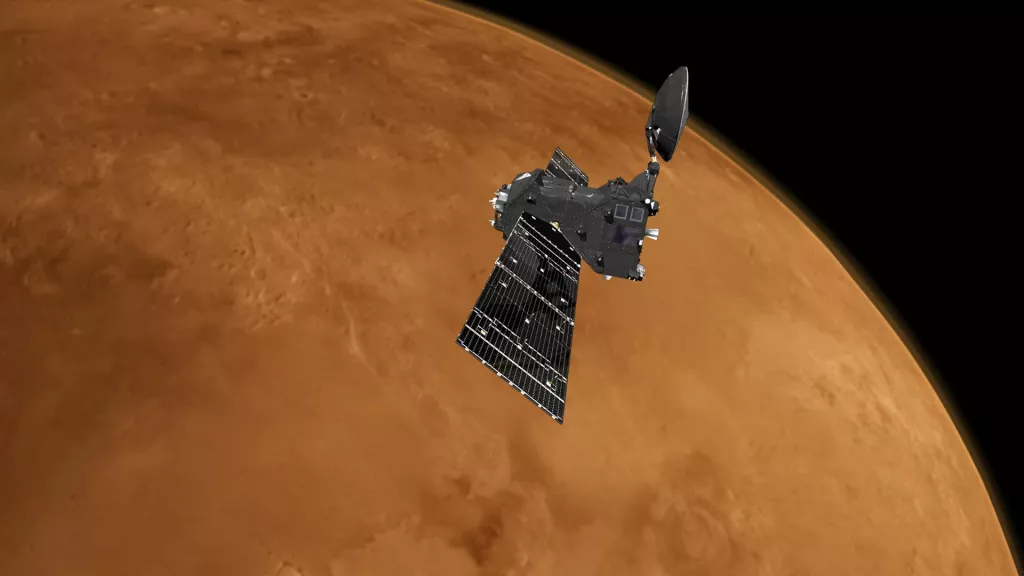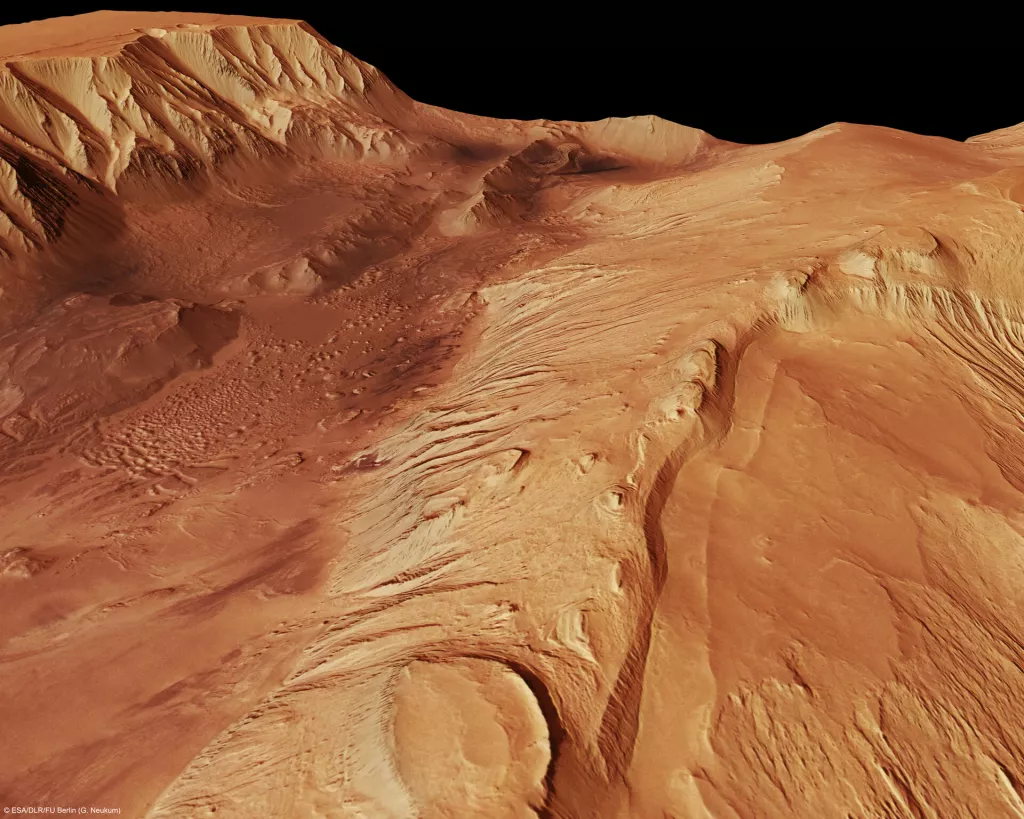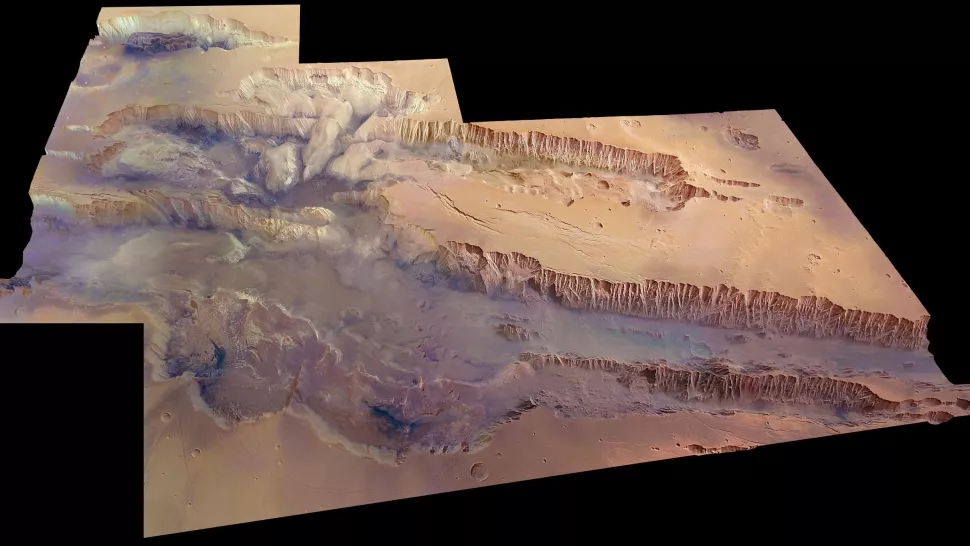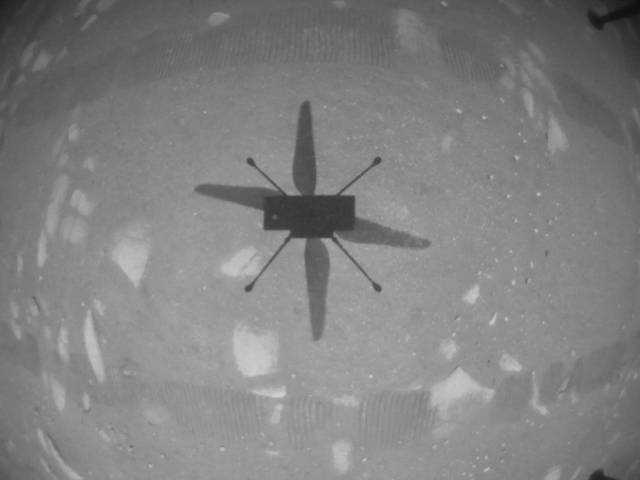Giant reservoir of ‘hidden water’ discovered on Mars
The water likely exists as ice, making the region ripe for future exploration.
By Ben Turner
12/18/2021

An enormous cache of water has been found just a few feet beneath the surface of Mars.
The European Space Agency’s ExoMars orbiter has discovered “significant amounts of water” in the Valles Marineris canyon, the largest known canyon in the solar system. According to the researchers, 40 percent of the near-surface material of the 15,830 square mile (41,000 square kilometer) region could be water ice.

Data beamed back from the Trace Gas Orbiter’s (TGO) Fine-Resolution Epithermal Neutron Detector (FREND) instrument found unusually high levels of hydrogen, which alongside oxygen makes up water, at a site called Candor Chaos — a Netherlands-size region located at the heart of Valles Marineris. Since life on Earth is highly dependent on water, evidence of water on Mars could be a vital clue that the planet was once home to life — or that life could still be there.
Dec 16, 2021
On December 15, 2021 ESA-Roscosmos ExoMars Trace Gas Orbiter (ESA) published scientific material to declare detection of significant amounts of water at the heart of Mars’ dramatic canyon system, Valles Marineris (Grand Canyon). The newly discovered volume of water is hiding under the surface of Mars, and was detected by the Trace Gas Orbiter, a mission in its first stage under the guidance of the ESA-Roscosmos project dubbed ExoMars. Gas Orbiter revealed an area with an unusually large amount of hydrogen in the colossal Valles Marineris canyon system: assuming the hydrogen we see is bound into water molecules, as much as 40% of the near-surface material in this region appears to be water. Igor Mitrofanov, the Russian Academy of Science’s lead investigator of the Space Research Institute, presented this discovery in the ESA press release.
Credit: esa.int, ESA-Roscosmos ExoMars
The research, completed as part of a shared operation between the ESA and the Russian space agency, Roscosmos, is set to be published in the March 2022 edition of the journal Icarus, and was published online on Nov. 19.
“We found a central part of Valles Marineris to be packed full of water — far more water than we expected,” co-author Alexey Malakhov, a scientist at the Space Research Institute of the Russian Academy of Sciences, said in a statement. “This is very much like Earth’s permafrost regions, where water ice permanently persists under dry soil because of the constant low temperatures.”
If the hydrogen detected is indeed bound together with oxygen to form water molecules, “as much as 40 percent of the near-surface material in this region appears to be water,” study lead author Igor Mitrofanov said in the statement.
The Valles Marineris canyon is a gigantic tectonic crack in the Martian surface smoothed out and broadened by erosion from wind and possibly water. The canyon is more than 2,500 miles (4,000 kilometers) long and 5 miles (8 km) deep, making it 10 times longer and five times deeper than Arizona’s Grand Canyon. According to NASA, if the Valles Marineris were on Earth, the gigantic canyon would stretch across the continental United States — from New York all the way to California.

The TGO’s FREND instrument enables the orbiter, which has been circling the Red Planet since 2018, to scan for clues of water by detecting neutrons emitted at or just below the Martian surface. As neutrons form when energetic particles called cosmic rays strike the Martian soil, drier surfaces emit more neutrons than wetter ones — enabling the team to calculate the amount of water on a surface by looking at the number of neutrons it produces. This method allows the TGO to detect water as far as 3.28 feet (1 meter) below the Martian surface.
In the past, when scientists have searched for water ice in Mars’ equatorial region, they have only been able to find odd traces of the substance clinging to the dust on its surface. Now that the TGO can penetrate to the upper subsurface, our ability to find pockets of water on the Red Planet has expanded dramatically.
“With TGO, we can look down to one metre below this dusty layer and see what’s really going on below Mars’ surface — and, crucially, locate water-rich ‘oases’ that couldn’t be detected with previous instruments,” Mitrofanov said.
More observations will be needed before researchers can identify what type of water they have discovered — whether its ice or has become chemically bonded to minerals in the soil. But given that so much of the near-surface material in the region appears to be water, “overall, we think this water more likely exists in the form of ice,” Malakhov said.
Dec 18, 2021
Scientists have found another pocket of water in the Valles Marineris canyon on Mars, according to ANU astrophysicist and cosmologist Dr Brad Tucker.
“Valles Marineris is this giant canyon on Mars, so it’s about 4,000 kilometres wide or long, so it’s wider than Australia, 200 across, and it could be seven kilometres deep, it could be the Grand Canyon on steroids,” he told Sky News Australia.
Dr Tucker said it is believed to have been formed by erosions like canyons on Earth, and underneath a probe has proved there is liquid water.
“Everywhere we keep looking on Mars, we find ice, we find water underneath the surface,” he said.
“It becomes exciting because we really do think this place was hospitable, did have life, and then it strongly has the chance that’s there now and discoveries like this give us more places to look.”
Whatever form the water may take, the discovery has identified a large, easily-explorable reservoir of water that future rovers could land near and investigate — both for water and for signs of life.
“Knowing more about how and where water exists on present-day Mars is essential to understand what happened to Mars’ once-abundant water and helps our search for habitable environments, possible signs of past life, and organic materials from Mars’ earliest days,” Colin Wilson, ESA’s ExoMars Trace Gas Orbiter project scientist, said in the statement.
Originally published on Live Science.
Perseverance Mars Rover
NASA’s Ingenuity Mars Helicopter Succeeds in Historic First Flight
NASA
4/20/2021

Credits: NASA/JPL-Caltech
Monday, NASA’s Ingenuity Mars Helicopter became the first aircraft in history to make a powered, controlled flight on another planet. The Ingenuity team at the agency’s Jet Propulsion Laboratory in Southern California confirmed the flight succeeded after receiving data from the helicopter via NASA’s Perseverance Mars rover at 6:46 a.m. EDT (3:46 a.m. PDT).
“Ingenuity is the latest in a long and storied tradition of NASA projects achieving a space exploration goal once thought impossible,” said acting NASA Administrator Steve Jurczyk. “The X-15 was a pathfinder for the space shuttle. Mars Pathfinder and its Sojourner rover did the same for three generations of Mars rovers. We don’t know exactly where Ingenuity will lead us, but today’s results indicate the sky – at least on Mars – may not be the limit.”
The solar-powered helicopter first became airborne at 3:34 a.m. EDT (12:34 a.m. PDT) – 12:33 Local Mean Solar Time (Mars time) – a time the Ingenuity team determined would have optimal energy and flight conditions. Altimeter data indicate Ingenuity climbed to its prescribed maximum altitude of 10 feet (3 meters) and maintained a stable hover for 30 seconds. It then descended, touching back down on the surface of Mars after logging a total of 39.1 seconds of flight. Additional details on the test are expected in upcoming downlinks.
Credits: NASA/JPL-Caltech/ASU/MSSS
Ingenuity’s initial flight demonstration was autonomous – piloted by onboard guidance, navigation, and control systems running algorithms developed by the team at JPL. Because data must be sent to and returned from the Red Planet over hundreds of millions of miles using orbiting satellites and NASA’s Deep Space Network, Ingenuity cannot be flown with a joystick, and its flight was not observable from Earth in real time.
NASA Associate Administrator for Science Thomas Zurbuchen announced the name for the Martian airfield on which the flight took place.
“Now, 117 years after the Wright brothers succeeded in making the first flight on our planet, NASA’s Ingenuity helicopter has succeeded in performing this amazing feat on another world,” Zurbuchen said. “While these two iconic moments in aviation history may be separated by time and 173 million miles of space, they now will forever be linked. As an homage to the two innovative bicycle makers from Dayton, this first of many airfields on other worlds will now be known as Wright Brothers Field, in recognition of the ingenuity and innovation that continue to propel exploration.”
Ingenuity’s chief pilot, Håvard Grip, announced that the International Civil Aviation Organization (ICAO) – the United Nations’ civil aviation agency – presented NASA and the Federal Aviation Administration with official ICAO designator IGY, call-sign INGENUITY.
These details will be included officially in the next edition of ICAO’s publication Designators for Aircraft Operating Agencies, Aeronautical Authorities and Services. The location of the flight has also been given the ceremonial location designation JZRO for Jezero Crater.
As one of NASA’s technology demonstration projects, the 19.3-inch-tall (49-centimeter-tall) Ingenuity Mars Helicopter contains no science instruments inside its tissue-box-size fuselage. Instead, the 4-pound (1.8-kg) rotorcraft is intended to demonstrate whether future exploration of the Red Planet could include an aerial perspective.
This first flight was full of unknowns. The Red Planet has a significantly lower gravity – one-third that of Earth’s – and an extremely thin atmosphere with only 1% the pressure at the surface compared to our planet. This means there are relatively few air molecules with which Ingenuity’s two 4-foot-wide (1.2-meter-wide) rotor blades can interact to achieve flight. The helicopter contains unique components, as well as off-the-shelf-commercial parts – many from the smartphone industry – that were tested in deep space for the first time with this mission.
“The Mars Helicopter project has gone from ‘blue sky’ feasibility study to workable engineering concept to achieving the first flight on another world in a little over six years,” said Michael Watkins, director of JPL. “That this project has achieved such a historic first is testimony to the innovation and doggedness of our team here at JPL, as well as at NASA’s Langley and Ames Research Centers, and our industry partners. It’s a shining example of the kind of technology push that thrives at JPL and fits well with NASA’s exploration goals.”
Parked about 211 feet (64.3 meters) away at Van Zyl Overlook during Ingenuity’s historic first flight, the Perseverance rover not only acted as a communications relay between the helicopter and Earth, but also chronicled the flight operations with its cameras. The pictures from the rover’s Mastcam-Z and Navcam imagers will provide additional data on the helicopter’s flight.
“We have been thinking for so long about having our Wright brothers moment on Mars, and here it is,” said MiMi Aung, project manager of the Ingenuity Mars Helicopter at JPL. “We will take a moment to celebrate our success and then take a cue from Orville and Wilbur regarding what to do next. History shows they got back to work – to learn as much as they could about their new aircraft – and so will we.”
Perseverance touched down with Ingenuity attached to its belly on Feb. 18. Deployed to the surface of Jezero Crater on April 3, Ingenuity is currently on the 16th sol, or Martian day, of its 30-sol (31-Earth day) flight test window. Over the next three sols, the helicopter team will receive and analyze all data and imagery from the test and formulate a plan for the second experimental test flight, scheduled for no earlier than April 22. If the helicopter survives the second flight test, the Ingenuity team will consider how best to expand the flight profile.
More About Ingenuity
JPL, which built Ingenuity, also manages the technology demonstration project for NASA. It is supported by NASA’s Science, Aeronautics, and Space Technology mission directorates. The agency’s Ames Research Center in California’s Silicon Valley and Langley Research Center in Hampton, Virginia, provided significant flight performance analysis and technical assistance during Ingenuity’s development.
Dave Lavery is the program executive for the Ingenuity Mars Helicopter, MiMi Aung is the project manager, and Bob Balaram is chief engineer.
For more information about Ingenuity:
https://go.nasa.gov/ingenuity-press-kit
and
https://mars.nasa.gov/technology/helicopter
More About Perseverance
A key objective for Perseverance’s mission on Mars is astrobiology, including the search for signs of ancient microbial life. The rover will characterize the planet’s geology and past climate, pave the way for human exploration of the Red Planet, and be the first mission to collect and cache Martian rock and regolith (broken rock and dust).
Subsequent NASA missions, in cooperation with ESA (European Space Agency), would send spacecraft to Mars to collect these sealed samples from the surface and return them to Earth for in-depth analysis.
JPL built and manages operations of the Perseverance rover. JPL is managed for NASA by Caltech in Pasadena, California.
-end-
Alana Johnson / Grey Hautaluoma
Headquarters, Washington
202-672-4780 / 202-358-0668
alana.r.johnson@nasa.gov / grey.hautaluoma-1@nasa.gov
DC Agle
Jet Propulsion Laboratory, Pasadena, Calif.
818-393-9011
agle@jpl.nasa.govLast Updated: Apr 19, 2021Editor: Karen Northon
Tags: Perseverance Mars Rover

北美法律公益讲座安排
时间:周二到周五 晚间
5:30-7:00(西部时间)8:30-9:30(东部时间)
周二:如何准备遗嘱材料(遗嘱workshop)
周三:数据泄露和个人身份保护&事业机会说明会
周四:家庭法和婚姻法(周律师)
周五:人身伤害和索赔(朱律师)
Zoom:6045004698,密码:请私信或群里@我
另外:周三6:30(西部时间)
专题:99%华人移民不知道的法律问题(粤语专场)
Zoom 95190929213,密码:私信或群里@我



